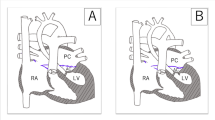Abstract
Norwood initially adopted the single Fontan procedure with a total cavopulmonary connection in the surgical treatment of hypoplastic left heart syndrome. Whether the surgical mortality or long-term mortality rates are very high. A large number of clinical experiments regarding the cavopulmonary connection for functional single ventricle have found that myocardial systolic function and the ratio of ventricular wall thickness to ventricular volume significantly increase after Fontan surgery. It might be deduced that, after implementation of a total cavopulmonary connection, the suddenly declined volume load of the single ventricle, which simultaneously sustains the systemic and pulmonary circulations, may contribute to myocardial quality degradation and cardiac volume reduction. Changes of myocardial volume–quality relationships could reduce myocardial systolic and diastolic function and might be the reason for the high overall mortality rate of one-time total cavopulmonary connections after the first stage of treatment for hypoplastic left heart syndrome.
Similar content being viewed by others
Norwood initially adopted the single Fontan procedure with a total cavopulmonary connection in the surgical treatment of hypoplastic left heart syndrome. Whether the surgical mortality or long-term mortality rates are very high. a large number of clinical experiments regarding the cavopulmonary connection for functional single ventricle have found that myocardial systolic function and the ratio of ventricular wall thickness to ventricular volume significantly increase after Fontan surgery. It might be deduced that, after implementation of a total cavopulmonary connection, the suddenly declined volume load of the single ventricle, which simultaneously sustains the systemic and pulmonary circulations, may contribute to myocardial quality degradation and cardiac volume reduction. Changes of myocardial volume-quality relationships could reduce myocardial systolic and diastolic function and might be the reason for the high overall mortality rate of one-time total cavopulmonary connections after the first stage of treatment for hypoplastic left heart syndrome.
A connection between the right pulmonary artery and the right atrium is generally adopted in the hemi-Fontan surgery. The incision method is analogous to the single Fontan surgery (Fig. 26.1).
In the classic Norwood hemi-Fontan surgery, only one patch is applied, not only to complete the cavopulmonary anastomosis, but also to separate the blood in the inferior vena cava from that in pulmonary artery (see Figs. 14.1, 14.2, 14.3, and 14.4). In the modified hemi-Fontan operation, the right pulmonary artery is first sutured to the right atrial rear wall with continuous sutures, and then the two suture ends are tightened (Fig. 26.2).
Blood flow from the superior vena cava is blocked from entering the right atrium and diverted into the pulmonary artery by placing a round Gore-Tex patch at the level of the inferior edge of the right atrial incision. The anastomosis of the right atrium to the pulmonary artery is also sewn closed with a Gore-Tex patch (Fig. 26.3).
After the hemi-Fontan operation, superior vena caval blood flows directly into pulmonary artery circulation, and inferior vena caval blood flows through the tricuspid valve into systemic circulation. The reason for which the procedure is called hemi-Fontan surgery is that the total cavopulmonary connection can be accomplished with the condition that the patch at the inlet of the superior vena cava can be removed, and a half-tunnel patch can then be added in the right atrium (Fig. 26.4).
Author information
Authors and Affiliations
Corresponding author
Editor information
Editors and Affiliations
Rights and permissions
Copyright information
© 2018 Springer Nature Singapore Pte Ltd. and People's Medical Publishing House Co. Ltd.
About this chapter
Cite this chapter
Weng, Y.G., Qiao, B. (2018). Stage II Norwood Procedure: Hemi-Fontan Surgery. In: Qiao, B., Liu, Z., Weng, Y., Yoganathan, A. (eds) Surgical Atlas of Functional Single Ventricle and Hypoplastic Left Heart Syndrome. Springer, Singapore. https://doi.org/10.1007/978-981-10-8435-5_26
Download citation
DOI: https://doi.org/10.1007/978-981-10-8435-5_26
Published:
Publisher Name: Springer, Singapore
Print ISBN: 978-981-10-8434-8
Online ISBN: 978-981-10-8435-5
eBook Packages: MedicineMedicine (R0)








